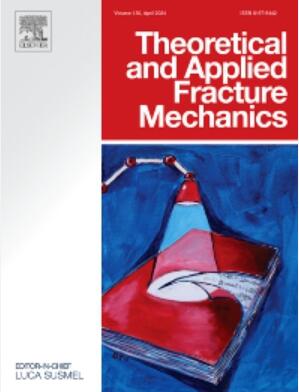准脆性材料混合模式断裂的围动力补偿临界能量密度准则
IF 5
2区 工程技术
Q1 ENGINEERING, MECHANICAL
引用次数: 0
摘要
本研究将补偿临界能量密度准则(CCED)集成到基于状态的普通围岩动力学框架中,以实现对模式 I、模式 II 和混合模式压裂的详细分析。所提出的键失效准则借鉴了传统临界能量密度 (CED) 的优点,能够精确计算应变能量密度。此外,临界粘结旋转准则(CR)还用于考虑 CED 可能忽略的剪切粘结。在制定整个计算框架时使用了周动态微分算子(PDDO)格式,从而提高了精度和数值稳定性。模型的验证是通过基准实例进行的,包括模式 I 双悬臂梁试验、模式 II 紧凑型剪切试验,以及预缺口试样的混合模式机械压裂试验和中心钻孔加载。收敛性研究、与有限元法模拟和理论解的对比分析全面检验了所提出模型的性能和准确性。本文章由计算机程序翻译,如有差异,请以英文原文为准。
A peridynamic compensated critical energy density criterion for mixed-mode fracturing in quasi-brittle materials
This study integrates a compensated critical energy density criterion (CCED) into the ordinary state-based peridynamics framework to enable detailed analysis of mode I, mode II, and mixed-mode fracturing. The proposed bond failure criterion builds upon the advantages of the traditional critical energy density (CED) to enable precise calculation of strain energy density. Additionally, the critical bond rotation criterion (CR) is employed to account for shear bonds that the CED might overlook. Using the peridynamic differential operator (PDDO) format in formulating the entire computational framework enhances both accuracy and numerical stability. The model’s validation is conducted through benchmark examples, including the mode I double cantilever beam test, the mode II compact shear test, and a mixed-mode mechanical fracturing test in pre-notched specimens with central borehole loading. Convergence studies, comparative analyses with finite element method simulations and theoretical solutions thoroughly examine the proposed model’s performance and accuracy.
求助全文
通过发布文献求助,成功后即可免费获取论文全文。
去求助
来源期刊

Theoretical and Applied Fracture Mechanics
工程技术-工程:机械
CiteScore
8.40
自引率
18.90%
发文量
435
审稿时长
37 days
期刊介绍:
Theoretical and Applied Fracture Mechanics'' aims & scopes have been re-designed to cover both the theoretical, applied, and numerical aspects associated with those cracking related phenomena taking place, at a micro-, meso-, and macroscopic level, in materials/components/structures of any kind.
The journal aims to cover the cracking/mechanical behaviour of materials/components/structures in those situations involving both time-independent and time-dependent system of external forces/moments (such as, for instance, quasi-static, impulsive, impact, blasting, creep, contact, and fatigue loading). Since, under the above circumstances, the mechanical behaviour of cracked materials/components/structures is also affected by the environmental conditions, the journal would consider also those theoretical/experimental research works investigating the effect of external variables such as, for instance, the effect of corrosive environments as well as of high/low-temperature.
 求助内容:
求助内容: 应助结果提醒方式:
应助结果提醒方式:


